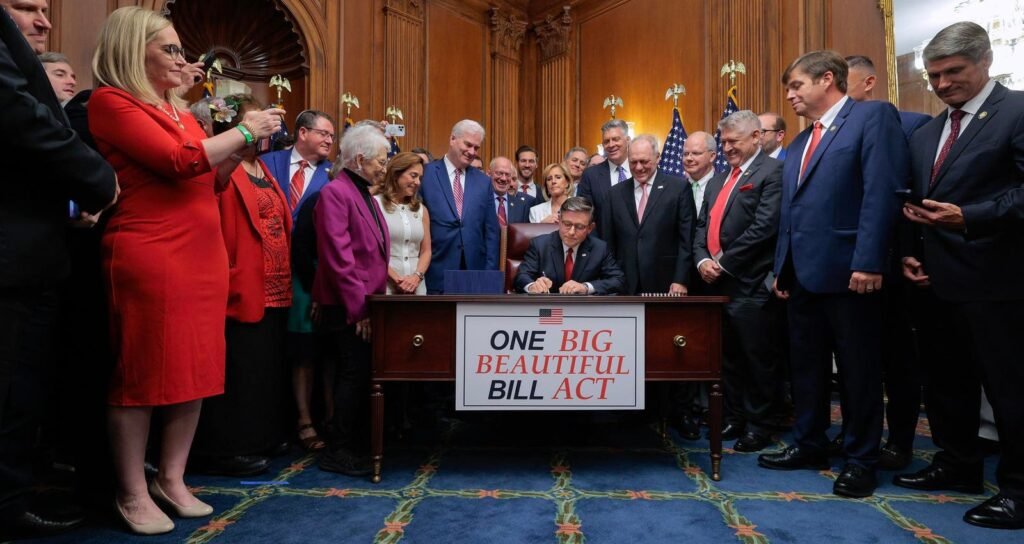WASHINGTON, DC – JULY 03: Speaker of the House Mike Johnson (R-LA) signs the One Big Beautiful Bill … More
The passing of the controversial “One Big Beautiful Bill” has sparked heated discussions. Critics raise concerns about potential Medicaid cuts and the influx of uninsured patients into emergency rooms. However, beneath the surface lies a more profound question – what kind of healthcare system are we upholding, and should we continue to sustain it?
The One Big Beautiful Bill signifies not only a political shift but also a fundamental reevaluation. Instead of solely focusing on budget reductions, policymakers and industry leaders must address the structural deficiencies that hinder access, quality, and long-term viability.
Amidst all the sensationalized speeches and alarming headlines, what the One Big Beautiful Bill truly indicates is a comprehensive effort to realign federal safety-net programs, especially Medicaid, towards a more restricted scope. This may be unsettling for many, but it instigates a necessary dialogue.
Key elements such as work prerequisites, biannual eligibility reassessments, and decreases in state-directed payments all highlight a central dilemma: who should receive coverage, and under what conditions?
As highlighted in a recent article, Medicaid was originally designed as a limited safety net, not a universal coverage program. Over time, its coverage has expanded without corresponding enhancements in efficiency or outcomes. The modifications proposed in the bill, though abrupt, aim to recalibrate this imbalance. Regardless of one’s stance on the approach, it underscores a growing unease with the notion that increased funding and enrollment automatically equate to improved healthcare.
It may be beneficial to differentiate between the rhetoric and the practical implications. The current challenge facing Congress is not solely fiscal but also structural. Without addressing these underlying issues, significant reform will remain elusive.
One of the few bipartisan provisions in the bill was the establishment of a $50 billion rural hospital relief fund. While crucial to prevent further closures of rural facilities, this type of emergency funding underscores a persistent problem: temporary financial aids often transform into permanent fixtures.
Rural hospitals are experiencing a crisis, with nearly half operating at a loss and closures on the rise. The collapse of rural healthcare extends beyond public health concerns; it poses a national security threat. Yet, infusing more funds into a failing model is not a sustainable long-term solution.
Instead of merely subsidizing struggling facilities, a shift in the delivery approach is imperative. A hub-and-spoke model that integrates pharmacies, local clinics, and telehealth services can offer sustainable access without the burdens of outdated infrastructure. Temporary measures should only serve as a bridge to lasting structural changes. Without this follow-through, they become another example of the healthcare system’s reliance on temporary fixes.
The deep-seated structural tension explains the vehement opposition from the hospital industry towards the bill. Hospitals are raising concerns about potential coverage losses and the vulnerability of the American public due to funding cuts. However, much of their apprehension revolves around the impact of these cuts on their financial bottom line.
As discussed in a recent piece, the apprehension is not solely about the disappearance of funding but also about the reevaluation of revenue streams that hospitals have grown dependent on. This discomfort could potentially drive innovation rather than instigate panic and a desire to maintain the status quo.
Many providers and advocates argue that reducing coverage is untenable because there isn’t sufficient funding to care for everyone otherwise. However, this presupposes that the system is already efficient, which is not the case. Studies have shown significant waste in healthcare spending, stemming from redundant tests, excessive administrative overhead, and outdated processes.
Instead of debating the affordability of healthcare expenditure, the focus should shift towards optimizing the utilization of existing resources. The resources are available; what’s lacking is accountability in how these funds are utilized.
The One Big Beautiful Bill has evoked mixed reactions, from outrage to approval. However, most analyses overlook the broader context. It’s not just about Medicaid cuts or rural healthcare bailouts; it’s about an unsustainable, inefficient healthcare ecosystem that is increasingly disconnected from value.
The objective shouldn’t be to preserve access at any cost. No country has limitless resources. A more effective approach would be to establish a system where cost and quality are intertwined, where financial investments drive outcomes, and where providers are incentivized to enhance care quality rather than quantity.
Short-term fixes won’t suffice. Only a fundamental reevaluation of the healthcare business model can lead to sustainable change. Despite its imperfections, the One Big Beautiful Bill initiates a crucial conversation in that direction.


